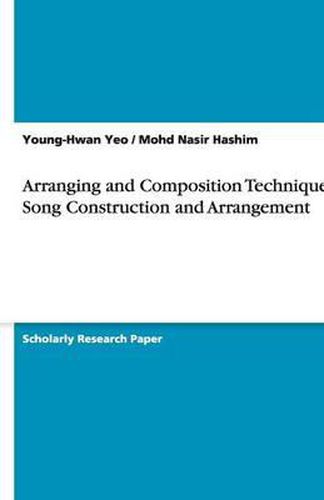Readings Newsletter
Become a Readings Member to make your shopping experience even easier.
Sign in or sign up for free!
You’re not far away from qualifying for FREE standard shipping within Australia
You’ve qualified for FREE standard shipping within Australia
The cart is loading…






Research paper from the year 2005 in the subject Musicology, The University of Malaya (Music Department), course: Scholarly Research Paper, language: English, abstract: In the early days of the pop industry, roles were more clearly defined. Songs were composed by songwriters, vocal and orchestral performances were extracted by producers, and the results recorded and mastered by audio engineers. The arranger’s task was to translate the chords and melodies into an orchestral score, which could then be performed in one take by a team of musicians. Today, of course, the modern palette of sounds is no longer limited to classical instruments, and arranging is often an integral part of the songwriting and production process. An incredible array of synthesisers, samplers and other tools is now available to aid the creative process, and digital technology allows us to shuffle the entire sections of music around until a perfect format is achieved. In pop music, above all, the role of an arranger has merged with those of a musician, programmer, producer and writer, to become a vital part of the creative process. For me, arranging is primarily about creating moods. A good arrangement should hook the listener from the introduction, and hold their attention through the song as the parts and melodies develop. Sounds and chord structures should work together to surround the vocal and evoke the appropriate emotions. Everyone has their own way of achieving this, and there can never be an ‘ultimate’ arrangement for any track - experimentation is the key. Songs can evolve from a wide range of starting points. You may be working from a demo, with many of the parts already defined, or you may have just a title. Either way, it’s good to start by taking an objective step back. Imagine how the song might sound on your car radio or your old radio at home. What sounds would grab your attention, and make you turn the radio up? As the mu
$9.00 standard shipping within Australia
FREE standard shipping within Australia for orders over $100.00
Express & International shipping calculated at checkout
Research paper from the year 2005 in the subject Musicology, The University of Malaya (Music Department), course: Scholarly Research Paper, language: English, abstract: In the early days of the pop industry, roles were more clearly defined. Songs were composed by songwriters, vocal and orchestral performances were extracted by producers, and the results recorded and mastered by audio engineers. The arranger’s task was to translate the chords and melodies into an orchestral score, which could then be performed in one take by a team of musicians. Today, of course, the modern palette of sounds is no longer limited to classical instruments, and arranging is often an integral part of the songwriting and production process. An incredible array of synthesisers, samplers and other tools is now available to aid the creative process, and digital technology allows us to shuffle the entire sections of music around until a perfect format is achieved. In pop music, above all, the role of an arranger has merged with those of a musician, programmer, producer and writer, to become a vital part of the creative process. For me, arranging is primarily about creating moods. A good arrangement should hook the listener from the introduction, and hold their attention through the song as the parts and melodies develop. Sounds and chord structures should work together to surround the vocal and evoke the appropriate emotions. Everyone has their own way of achieving this, and there can never be an ‘ultimate’ arrangement for any track - experimentation is the key. Songs can evolve from a wide range of starting points. You may be working from a demo, with many of the parts already defined, or you may have just a title. Either way, it’s good to start by taking an objective step back. Imagine how the song might sound on your car radio or your old radio at home. What sounds would grab your attention, and make you turn the radio up? As the mu